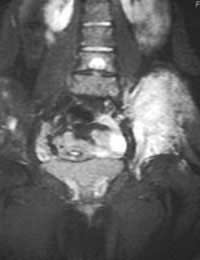Focus on Ewing's Sarcoma

Ewing’s sarcoma is a rare cancerous tumour of bone and soft tissue that affects 2 in every million children in the UK. Although it is classed as a childhood cancer, it is rarely diagnosed in children younger than five. Most cases are discovered in teenagers who are passing through puberty and this cancer is more common in boys than in girls. Around 6 times as many patients with Ewing’s sarcoma are male.
Although the cancer can affect the pelvis, ribs and skull, it is most usually found associated with the spine. Cases usually present with severe bone pain, which is usually experienced as back pain.
Diagnosing Ewing’s Sarcoma
As the disease is so rare, pain in teenage boys is usually due to some other, less life threatening cause. A positive diagnosis is usually obtained using a series of X-rays followed by Magnetic Resonance Imaging (MRI), which reveals the tumour as a white area in and around the affected bone. The more detailed images produced by MRI can show the full extent of the tumour and can be used, in combination with CT scanning, to assess how the tumour is responding to treatment.It can be difficult, even so, to distinguish a true Ewing’s sarcoma from osteomyelitis (an infection of the bone marrow), or an osteosarcoma (the most common form of bone cancer). Cancers such as histiocytomas, which arise in fibrous soft tissue, can also look very similar on MRI and CT scans.
Current Treatment Options
Although this is a serious disease, the five year survival rates are actually quite high after aggressive treatment, with 7 or 8 people out over every ten surviving for five years after diagnosis. If it is possible to remove the tumour or a large part of it by surgery, this option is usually taken up. Chemotherapy may be used for several weeks before the operation to reduce the tumour mass. If the tumour is in the pelvis, and has spread to the leg bones, it may be necessary to amputate the leg in order to save the patient.Chemotherapy is then used in the weeks and months after surgery to try to kill as many of the remaining cancer cells as possible, and to deal with any sites of secondary tumours. Several chemotherapy drugs are usually used, to prevent the tumour becoming resistant to therapy. Radiotherapy can also be used to further reduce the chance of recurrence.


Re: Who is at Risk of Developmental Back Pain?
I have been getting muscle spasms in my lower back for 30 years and when they occur I walk like an old man. I…
Re: A Spinal Tap Caused My Back Pain
When I was 14 I was sent to the emergency room with an illness the doctors couldn't identify. Extremely high fever and high…
Re: A Spinal Tap Caused My Back Pain
I've had spinal meningitis 7 times now. So much scar tissue they have to do x ray with the lumbar puncture. I am having a lot…
Re: A Spinal Tap Caused My Back Pain
Hello I had spinal tap done bout 8 month ago due to a brain aneurysm. I tell you someday they way my back is make me not…
Re: A Spinal Tap Caused My Back Pain
So about 7 or 8 months ago I got a spiral tap preformed due to have being diagnosed with Idiopathic intracranial…
Re: A Spinal Tap Caused My Back Pain
So about 7 or 8 months ago I got a spiral tap preformed due to have being diagnosed with Idiopathic intracranial…
Re: Dehydrated Discs
hI THERE, I have Dyhydration L3/l4 and ll4/l5 and disprotrusion and sequestrated discu after MRI i am aged 52. I had hip pain all night for 3…
Re: A Spinal Tap Caused My Back Pain
Hi . I also had a spinal Tap to check the stages of a bleeiding in my brain. This has caused me serious back pain almost…
Re: Dehydrated Discs
Alex - Your Question:I am a 27 yr old male who up until last year was working 84-108 hrs/week and always had back problems but all the doctors I…
Re: Dehydrated Discs
I am a 27 yr old male who up until last year was working 84-108 hrs/week and always had back problems but all the doctors i had seen told me its…